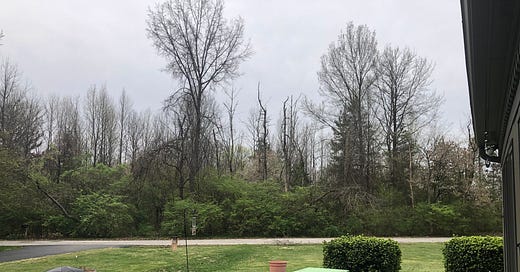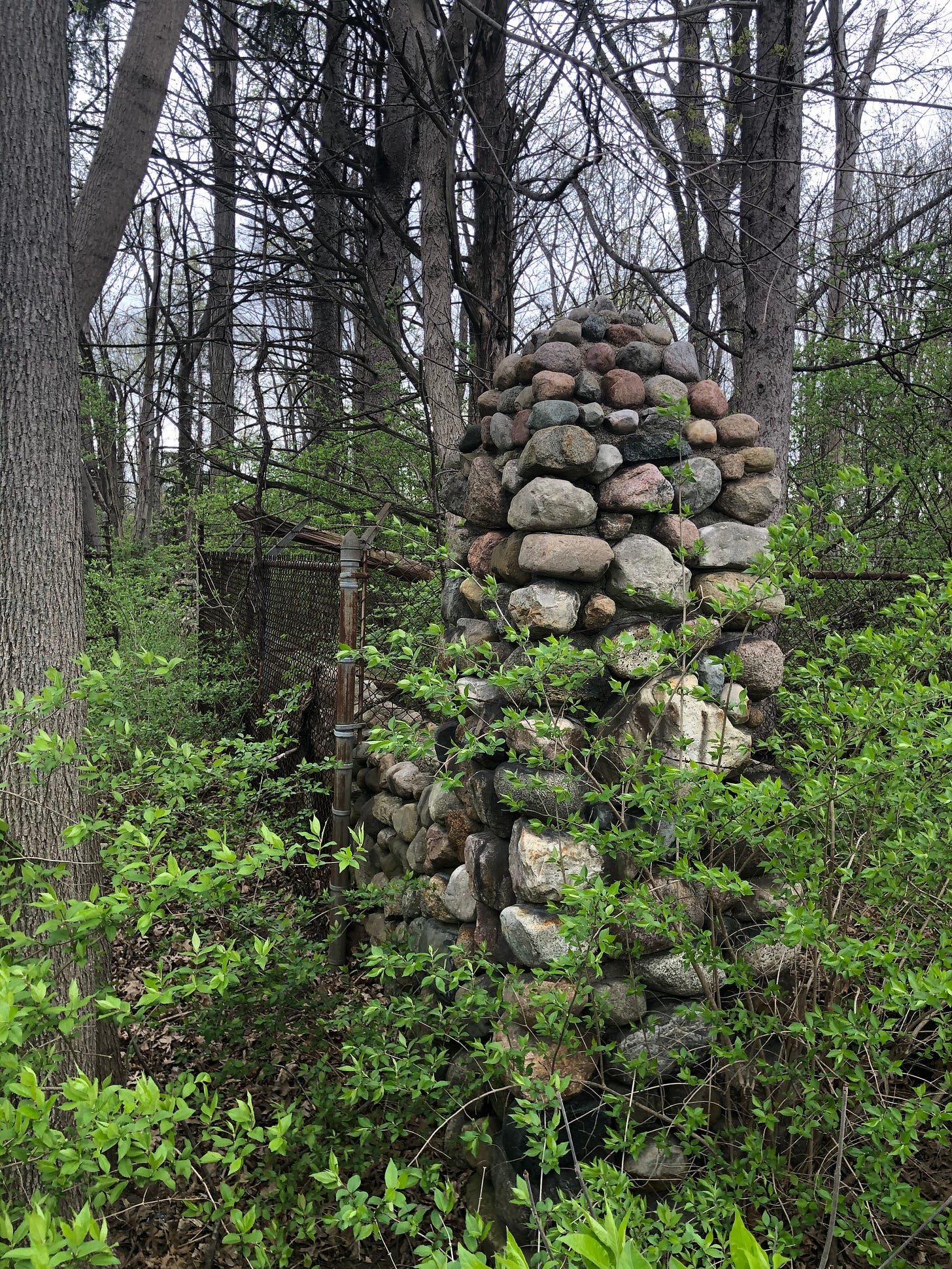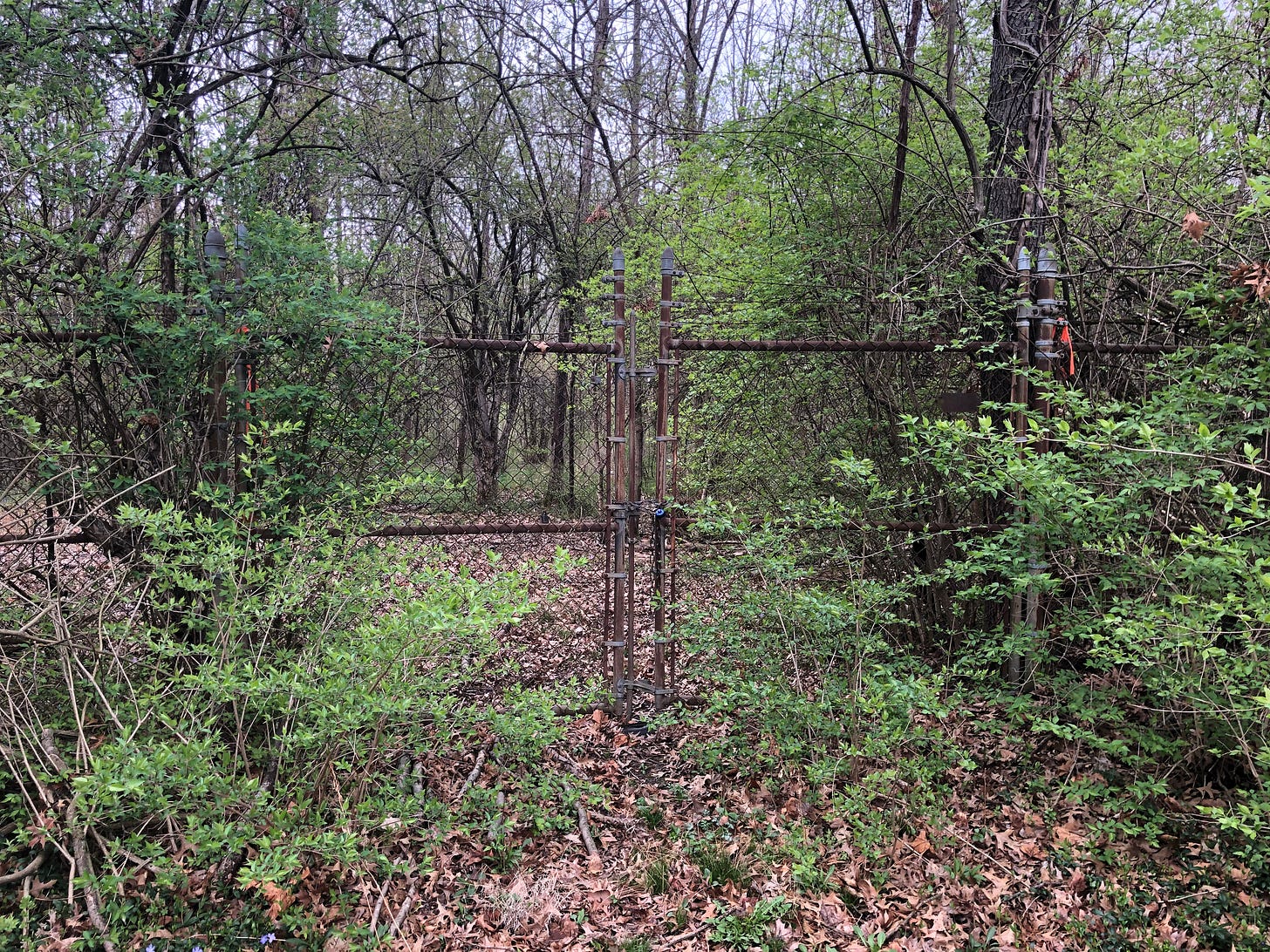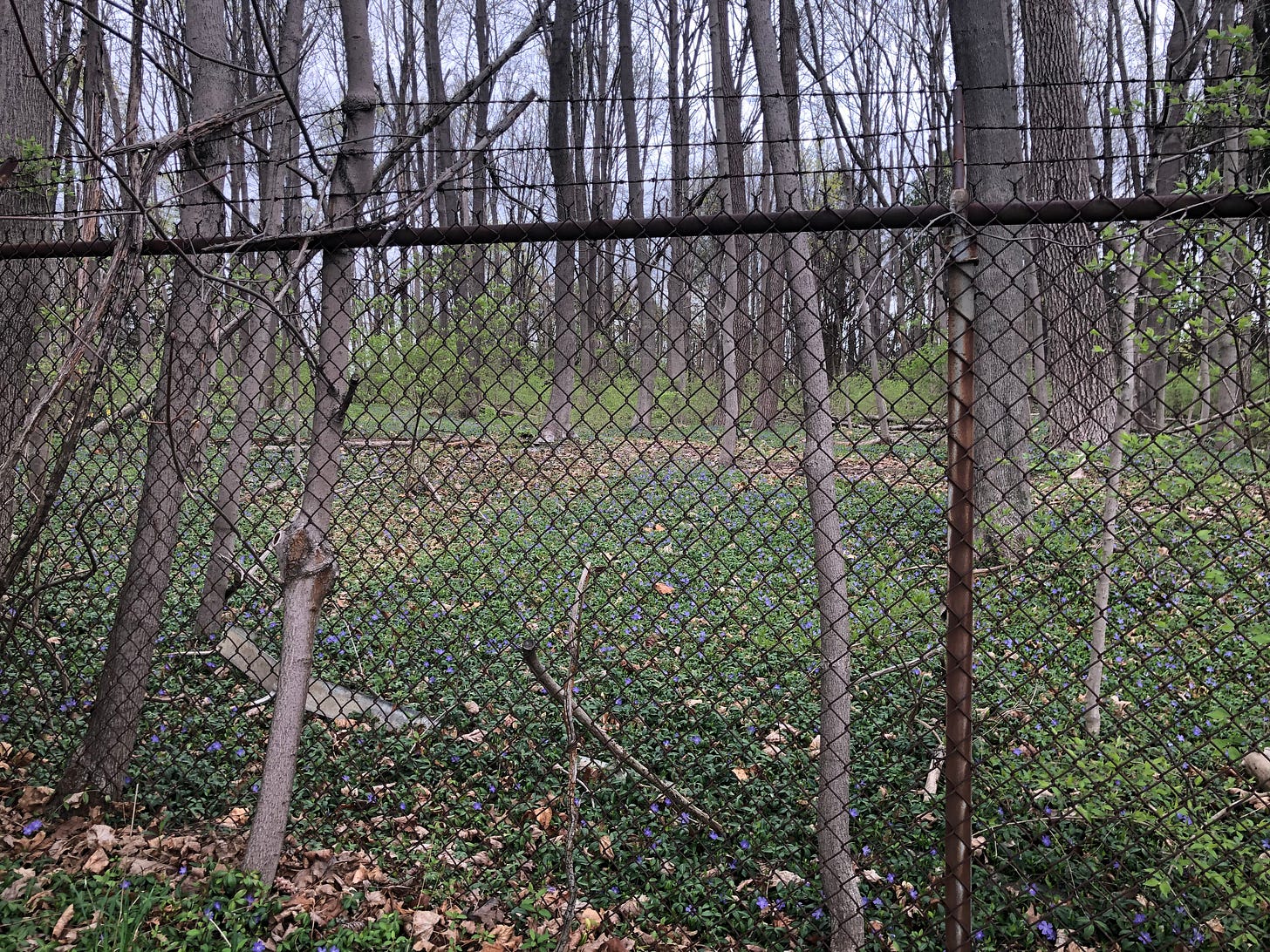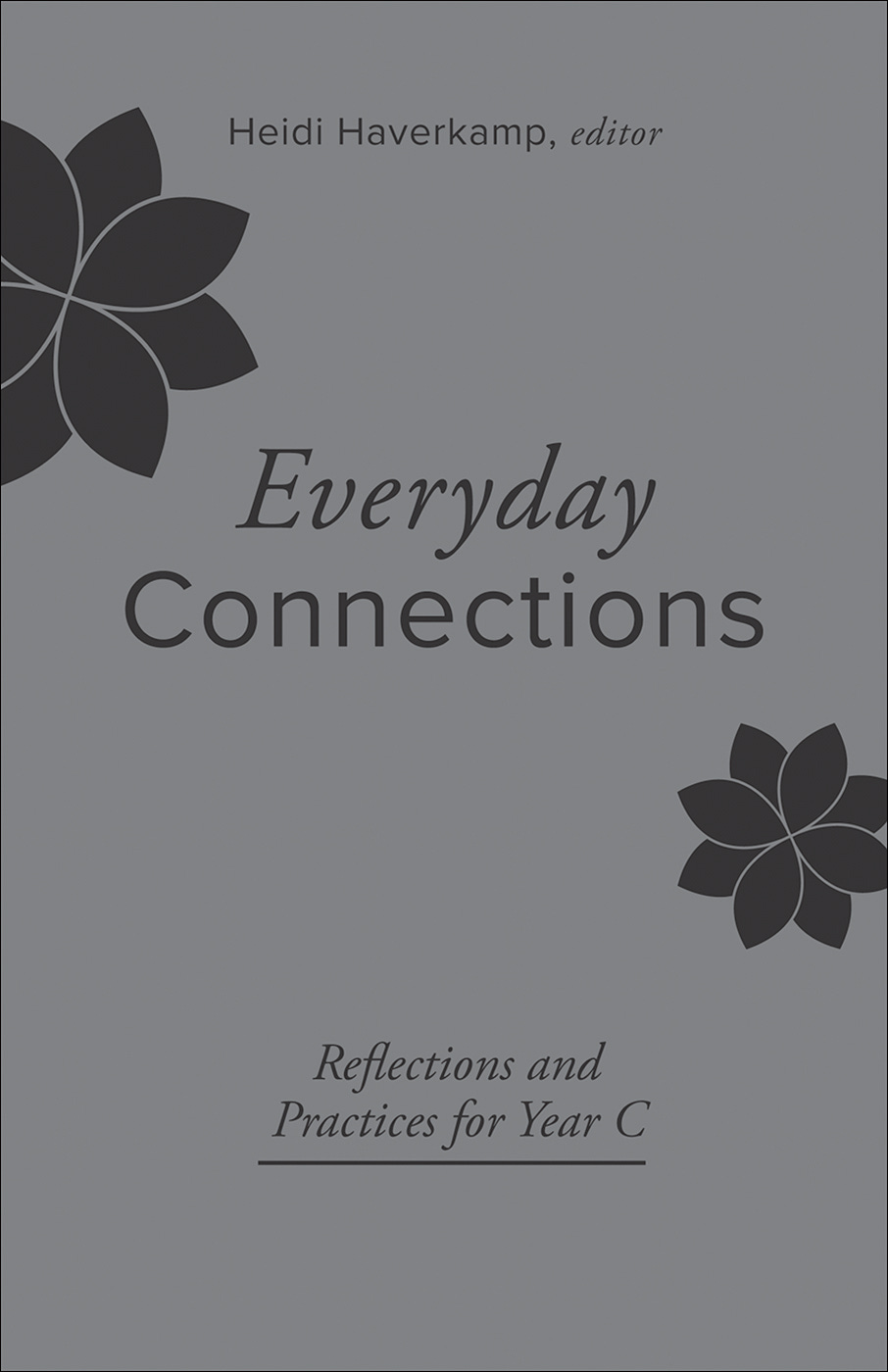The Wild Thicket Across the Street
The house we bought here in Indianapolis last fall is great, but it isn’t the hermit house of my dreams. I used to be obsessed with tiny houses (as I mention in the introduction to Holy Solitude). My favorite hermit, W. Paul Jones, built his hermitage in the Missouri woods on a lake with his own two hands. Cynthia Bourgeault, the famous Episcopal contemplative, lives in a cottage on an island off the coast of Maine (because, of course she does). But when you have two people who both work at home and who both use Zoom regularly, you can’t really live in a tiny house. Or even a small house. You need two offices, somehow or other. You also need high-speed internet, which is hard to come by in backwoods Missouri and on smaller coastal islands, or so I imagine. So, I had to give up on the hermit dream house.
In fact, we bought a ranch with four bedrooms – much bigger than we were planning, but the house has two rooms on either side of the house (so we can’t hear each other on calls) that are basically each our Platonic ideal for an office. Sometimes, practicality has to win out over romance, even in the spiritual life. Sometimes practicality actually makes your spiritual life better.
The other reason we bought this house is that it’s on a great big lot in a pretty suburban, uncrowded part of Indianapolis, so there aren’t a lot of buildings close around the property. So, we have wide swathes of the sky visible from half of our windows and buckets of sunlight pour right in (stay tuned for what this is like in summertime…).
Across the street from the front of our house is a golf course – how much more suburban can you get? But we’re on a corner, and in contrast, across the street on the side is a 4-acre, overgrown, wooded lot.
It seems to have been for sale on and off. It’s got a barbed wire fence around it and a padlocked gate. It also has a smaller gate standing wide open, which a flock of deer wander in and out of in as they stroll around our neighborhood. There are stone pillars all around, and a stone bridge over a creek.
So on one side, we basically have this little nature preserve – barbed wire notwithstanding – and on the other side, manicured lawn, water traps, and sand traps. (Interestingly, the golf course is fenced, but not with barbed wire.) One side is The Wild, and the other, Control. Or, on one side is A Mess, and on the other, Landscaped Design.
My office faces The Wild Mess. (This is unspeakably fitting, folks.)
I often sit and think about what it will be like when the The Wild is sold and someone comes and cuts all those trees down, bulldozes the stone work, and builds who-knows-what. Zoning means it won’t be a gas station or a strip mall, but it could be townhouses or some kind of wealthy estate home. In any case, there will be noise, dust, and a lot of wildlife habitat lost. Where will those deer go next?
The Wild Mess is chaotic. It’s brushy, spiked with dead trees, home to invasive species like Bradford pear and buckthorn, and people dump trash, dead leaves, and brush along the fence. (They also dump this crap along the golf course fence, btw. It’s just they have staff to come pick it up now and then.)
My Uncle Roy likes to tell the story that, when I was about four years old, I would point at different corners of my parents’ house and declare to any who would listen: “Mess!” As the oldest daughter of two busy parents, who gave up on housework pretty early in life with kids, I kept my room neat as a pin, and developed a little bit of a complex about clutter and unfinished projects. “Mess,” my mind, even now, continues to want to say.
I wonder sometimes, if this is part of the allure of a tiny house – small, easy to keep clean, a sort of Instagram-romance-idea of “home.” (Of course, this is a fallacy – talk to or read an article online by anyone who’s actually lived in a tiny house.) I wonder if this is also the drive behind the modern craze for minimalism – clean, white, empty spaces, or drives to throw away most of what you own so you can have “energy,” “freedom,” or whatever.
The thing is, to be alive is to have clutter. To have a life of freedom and fruitfulness probably means we can’t keep our homes perfectly tidy all the time. Also, we need stuff to live. And if we throw everything away, we’re going to have to go buy at least some of that stuff again when we find we need it after all. (Has this happened to me? Ha. Please, don’t ask my husband.)
One of my favorite spots at a farm where I worked in my twenties was called The Red Barn. It was a giant junk closet. Basically a fire trap (they finally tore it down a few years ago), but full of ancient, decaying, glorious stuff – wooden skies, old parkas, yards of dusty books, beat-up but solid wood furniture, and creaky, decades-old chest freezers in the basement that we’d fill with frozen vegetables and tomato sauce every fall. If you needed something, and weren’t too picky, you could probably find it or a suitable stand-in in The Red Barn. Or you’d find something you didn’t know you wanted, and be sort of amazed. You could also bring your old stuff and leave it in the Barn for someone else to find.
Messes are fertile, it seems to me. Messes beget life (and not just bacteria, c’mon). Of course, try telling that to 4-year old me. Or the country club owners. But there’s not much that lives on the golf course. There’s not much to discover in an empty, decluttered closet. There’s not much that lives in the giant lawn around our new house. (Not yet. Just wait.)
A final confession: around our house in DeKalb, there were two dying trees and two wall of overgrown bushes and saplings that had been allowed to grow into a tangle over decades. It was A Mess. The whole time we lived there, I was on a tear to Fix It. But it was Wild, with birds, a pair of squirrels, and lots of bugs, I’m sure. Still, we tore it all out. Now, one tree really did need to come down, but the rest? Did we need to clean out every last square foot?
Are there any places in your life that your mind often points to and declares, “Mess!”? Consider: is it, really, a mess? Or is it The Wild? Is there some fertility there? What if the “mess” will offer us something we need one of these days? What if something important is living there? What do we need to control and what can we let go?
I think this is also why so many hermits have lived in wild places, over the centuries: deserts, mountains, forests, islands. There is an unkempt fruitfulness in those places – places beyond human control, beyond Landscaped Design. I can’t live in a place like that, now, but the 4-acre thicket across the street, even if it becomes a bunch of townhouses someday, has been talking to me while it still can, and I am grateful.
Heidi
New Book!
My next book is available for pre-order! It's called Everyday Connections: Reflections and Practices for Year C. It's a year-long devotional based on the Sunday lectionary readings and the commentary series "Connections." Year C starts this coming Advent, so it comes out in September (with two more volumes to come: Year A in 2022, Year B in 2023). It’s expensive ($35 full price) because it’s a whole year’s worth of devotions - clocking in at almost 550 pages long. But there’s a nice leatherette cover to hold up for extended use and I promise, it’s full of goodies. You can use as an individual or with your small group.
How Readers Can Help
Self-promotion is painful for even part-time hermits, and honestly, for most authors, too. But we have to do a little now and then! Sometimes people ask how they can help me as an author: which store should they use to buy my books? (My first two are Advent in Narnia and Holy Solitude.) My answer is that it doesn’t really matter, because whether you support and pay more for my book at an independent bookstore or boost my popularity on Amazon, both are good outcomes. Here are some other ways you can help my work as a writer:
Review my books on Amazon or Goodreads, particularly. This is great for algorithms, and people do read the reviews. Even a brief one - or just clicking on a number of stars (no matter what number, keep it real, my friends) - helps.
Pre-order Everyday Connections. Pre-ordering is also what props up those algorithms.
You might tell friends, your pastor or rector, or other congregational leaders about my work. All my books were written to be used in congregational programming and/or small groups as well as by individuals, so if you think it would be fun to use one of my books at your church, suggest it to your leaders or start a group yourself. Both Advent in Narnia and Everyday Connections have a curriculum format in the appendix. If I can help, just let me know! Contact me by clicking here.
Share this column with someone you think might like it.
Thanks all. Respond below or to your email if you have any questions or comments! Or Contact Me via my website: https://heidihaverkamp.net/
